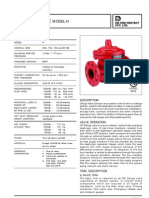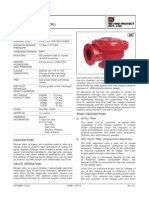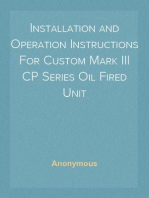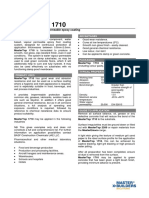9/27/01 AC 43.13-1B CHG 1: Figure 12-5. Pitot/static System For A Small Aircraft
9/27/01 AC 43.13-1B CHG 1: Figure 12-5. Pitot/static System For A Small Aircraft
Uploaded by
aerogem618Copyright:
Available Formats
9/27/01 AC 43.13-1B CHG 1: Figure 12-5. Pitot/static System For A Small Aircraft
9/27/01 AC 43.13-1B CHG 1: Figure 12-5. Pitot/static System For A Small Aircraft
Uploaded by
aerogem618Original Description:
Original Title
Copyright
Available Formats
Share this document
Did you find this document useful?
Is this content inappropriate?
Copyright:
Available Formats
9/27/01 AC 43.13-1B CHG 1: Figure 12-5. Pitot/static System For A Small Aircraft
9/27/01 AC 43.13-1B CHG 1: Figure 12-5. Pitot/static System For A Small Aircraft
Uploaded by
aerogem618Copyright:
Available Formats
9/27/01
AC 43.13-1B CHG 1
SECTION 4. PITOT/STATIC SYSTEMS 12-51. GENERAL. In order for the pitotstatic instruments to work properly, they must be connected into a system that senses the impact air pressure with minimum distortion and picks up undisturbed static air pressure. Pitot pressure is ram air pressure picked up by a small open-ended tube about a -inch in diameter that sticks directly into the air stream that produces a pressure proportional to the speed of the air movement. Static pressure is the pressure of the still air used to measure the altitude and serves as a reference in the measurement of airspeed. Airspeed requires pitot, altimeter, rate of climb, and transponder-required static. 12-52. SYSTEM COMPONENTS. The conventional design of the pitot system consists of pitot-static tubes or pitot tubes with static pressure parts and vents, lines, tubing, water drains and traps, selector valves, and various pressure-actuated indicators or control units such as the altimeter, airspeed and rateof-climb indicators, and the encoding altimeter connected to the system. (See figure 12-5.) 12-53. PITOT/STATIC TUBES AND LINES. The pitot tube (see figure 12-6) is installed at the leading edge of the wing of a single-engine aircraft, outside the propeller slipstream or on the fuselage of a multiengine aircraft with the axis parallel to the longitudinal axis of the aircraft, unless otherwise specified by the manufacturer. 12-54. STATIC PORTS AND VENTS (more modern trend) should be mounted flush with fuselage skin. One port is located on either side of the fuselage, usually behind the cabin. Inspect for elevation or depression of the port or vent fitting. Such elevation or depression may cause airflow disturbances at high speeds and result in erroneous airspeed and altitude indications. 12-55. HEATER ELEMENTS. A heating element is located within the tube head to prevent the unit from becoming clogged during icing conditions experienced during flight. A switch in the cockpit controls the heater. Some pitot-static tubes have replaceable heater elements while others do not. Check the heater element or the entire tube for proper operation by noting either ammeter current or that the tube or port is hot to the touch. (See figure 12-6.) 12-56. SYSTEM INSPECTION. a. Inspect air passages in the systems for water, paint, dirt or other foreign matter. If water or obstructive material has entered the system, all drains should be cleaned. Probe the drains in the pitot tube with a fine wire to remove dirt or other obstructions. The bottom static openings act as drains for the heads static chamber. Check these holes at regular intervals to preclude system malfunctioning.
Figure 12-5. Pitot/static system for a small aircraft.
Par 12-51
Page 12-19
AC 43.13-1B CHG 1
9/27/01
Figure 12-6. Pitot/Static Tube Head
b. Check to ensure the water drains freely. If a problem is experienced with the pitot-static system drainage or freezing at altitude, and the tubing diameter is less than 3/8-inch, replace it with larger tubing. c. Check the pitot tube for corrosion.
NOTE: It is essential that the static air system be drained after the airplane has been exposed to rain. 12-57. SYSTEM LEAK TEST. a. Pitot-static leak tests should be made with all instruments connected to assure that no leaks occur at instrument connections. Such tests should be accomplished whenever a connection has been loosened or an instrument replaced.
(1) The pitot probe should not have any corrosion within -inch of the probe tip. (2) Make sure there is no flaking which forms pits and irregularities in the surface of the tube.
Page 12-20
Par 12-56
9/27/01
AC 43.13-1B CHG 1
b. After the conclusion of the leak test, return the system to its normal flying configuration. Remove tape from static ports and pitot drain holes and replace the drain plug. 12-58. STATIC SYSTEM TESTS must comply with the static system tests required by 14 CFR 91.411 and be performed by an appropriately-rated repair station with the appropriate test equipment. If the manufacturer has not issued instructions for testing static systems, the following may be used: a. Connect the test equipment directly to the static ports, if practicable. Otherwise, connect to a static system drain or tee connection and seal off the static ports. If the test equipment is connected to the static system at any point other than the static port, it should be made at a point where the connection may be readily inspected for system integrity. Observe maintenance precautions given in paragraph 12-60 of this section. b. Do not blow air through the line toward the instrument panel. This may seriously damage the instruments. Be sure to disconnect the instrument lines so no pressure can reach the instruments. c. Apply a vacuum equivalent to 1,000 feet altitude, (differential pressure of approximately 1.07 inches of mercury or 14.5 inches of water) and hold. d. After 1 minute, check to see that the leak has not exceeded the equivalent of 100 feet of altitude (decrease in differential pressure of approximately 0.0105 inches of mercury or 1.43 inches of water). 12-59. TEST PITOT SYSTEM in accordance with the aircraft manufacturers instructions. If the manufacturer has not issued inPar 12-57
structions for testing pitot systems, the following may be used: a. Seal the drain holes and connect the pitot pressure openings to a tee to which a source of pressure and manometer or reliable indicator is connected. b. Restrain hoses that can whip due to applied pressure. c. Apply pressure to cause the airspeed indicator to indicate 150 knots (differential pressure 1.1 inches of mercury or 14.9 inches of water), hold at this point and clamp off the source of pressure. After 1 minute, the leakage should not exceed 10 knots (decrease in differential pressure of approximately 0.15 inches of mercury or 2.04 inches of water). CAUTION: To avoid rupturing the diaphragm of the airspeed indicator, apply pressure slowly and do not build up excessive pressure in the line. Release pressure slowly to avoid damaging the airspeed indicator. d. If the airspeed indicator reading declines, check the system for leaky hoses and loose connections. e. Inspect the hoses for signs of deterioration, particularly at bends and at the connection points to the pitot mast and airspeed indicator. Replace hoses that are cracked or hardened with identical specification hoses. Any time a hose is replaced, perform a pressure check. Warning: Do not apply suction to pitot lines. 12-60. MAINTENANCE PRECAUTIONS. Observe the following precautions in all pitotstatic system leak testing:
Page 12-21
AC 43.13-1B CHG 1
9/27/01
a. Before any pitot/static system is tested, determine that the design limits of instruments attached to it will not be exceeded during the test. To determine this, locate and identify all instruments attached to the system. b. A system diagram will help to determine the location of all instruments as well as locate a leak while observing instrument indications. If a diagram is not available, instruments can be located by tracing physical installation. c. Be certain that no leaks exist in the test equipment. d. Run full range tests only if you are thoroughly familiar with the aircraft instrument system and test equipment. e. Make certain the pressure in the pitot system is always equal to, or greater than, that in the static system. A negative differential pressure across an airspeed indicator can damage the instrument. f. The rate of change or the pressure applied should not exceed the design limits of any pitot or static instruments connected to the systems. g. When lines are attached to or removed from the bulkhead feed-through fitting or at a union, ensure the line attached to the opposite end is not loose, twisted, or damaged by rotation of the fitting. Such fittings normally are provided with a hex flange for holding the fitting. 12-61. REPLACING LINES. If necessary to replace lines, observe the following installation: a. Attach lines at regular intervals by means of suitable clamps.
b.
Do not clamp lines at end fittings.
c. Maintain the slope of lines toward drains to ensure proper drainage. d. Check the lines for leaks.
12-62. RELOCATON OF PITOT TUBE. If pitot tube relocation is necessary, perform the relocation in accordance with the manufacturers recommendations and consider the following: a. Freedom of aerodynamic disturbances caused by the aircraft. b. Location protected from accidental damage. c. Alignment with the longitudinal axis of the aircraft when in cruising flight. 12-63. TROUBLESHOOTING THE TOT/STATIC PRESSURE SYSTEM. PI-
a. If instruments are inoperative or erratic operation occurs, take the following action:
Table 12-1. Color codes for pitot-static systems.
CODE ABBR. DEFINITION COLOR
PP
SP
PITOT PRESSURE STATIC PRESSURE (PILOT) STATIC PRESSURE (CO-PILOT) STATIC PRESSURE (CABIN) STATIC PRESSURE (STANDBY)
NATURAL
RED GREEN
YELLOW
BLUE
Page 12-22
Par 12-60
9/27/01
AC 43.13-1B CHG 1
(1) Check for clogged lines. Drain lines at the valves (especially after aircraft has been exposed to rain). Disconnect lines at the instruments and blow them out with low-pressure air. (2) Check lines for leaks or looseness at all connections. Repair as required. b. If the pitot heating element(s) are operative, check the following: (1) Are circuit breaker(s) tripped? (2) Reset the circuit breaker to determine if: (a) The system is OK, or (b) The circuit breaker trips again, if so: 1. Check the wiring continuity to the ground. If the switch(s) is defective, repair as necessary. 2. Check the heating element; replace it if it is defective. 12-64.12-69. [RESERVED.]
Par 12-57
Pages 12-23 (and 12-24)
You might also like
- Life On Mars Poems by Tracy K Smith 1555975844 PDFDocument5 pagesLife On Mars Poems by Tracy K Smith 1555975844 PDFMonica Montero0% (1)
- FAT ProcedureDocument6 pagesFAT Procedurebmanojkumar16100% (2)
- Advanced Temperature Measurement and Control, Second EditionFrom EverandAdvanced Temperature Measurement and Control, Second EditionNo ratings yet
- Practical Guides to Testing and Commissioning of Mechanical, Electrical and Plumbing (Mep) InstallationsFrom EverandPractical Guides to Testing and Commissioning of Mechanical, Electrical and Plumbing (Mep) InstallationsRating: 4 out of 5 stars4/5 (4)
- Reading ApproachDocument30 pagesReading ApproachCheiryl Dandoy75% (4)
- Buxton-IOM TEST PUMP S10G-M THRU S30G-M TestUnits IOM rvB1 2Document16 pagesBuxton-IOM TEST PUMP S10G-M THRU S30G-M TestUnits IOM rvB1 2Wayne100% (2)
- Deluge Valve HD FireDocument14 pagesDeluge Valve HD FireKeshodbana KeshodNo ratings yet
- SQL Questions & AnswersDocument9 pagesSQL Questions & AnswersTsehayou SieleyNo ratings yet
- Phanikumar TransportPhenomenaNotes 01feb2010Document109 pagesPhanikumar TransportPhenomenaNotes 01feb2010aalisafa50% (2)
- TP201.3A Determination of 5 Inch WC Static Pressure Performance of Vapor Recovery Systems of Dispensing FacilitiesDocument10 pagesTP201.3A Determination of 5 Inch WC Static Pressure Performance of Vapor Recovery Systems of Dispensing FacilitiesCésar Oswaldo Aguilera OjedaNo ratings yet
- Chiller Testing Procedure Rev 1Document15 pagesChiller Testing Procedure Rev 1Ali AimranNo ratings yet
- Test Stand Technical ManualDocument51 pagesTest Stand Technical Manualewhf weGJO100% (1)
- Pitot Static Leak TestDocument4 pagesPitot Static Leak Testsamuelkasoka641No ratings yet
- Ngineering ATA: Field Testing of FansDocument5 pagesNgineering ATA: Field Testing of FansMohamed TahounNo ratings yet
- Hydrotest Procedure For Piping SystemsDocument6 pagesHydrotest Procedure For Piping Systemscatherine100% (1)
- Hydranautics TAB142 LDocument9 pagesHydranautics TAB142 LMax JunghannsNo ratings yet
- Procedure For Hydro Testing: Pressure TestDocument5 pagesProcedure For Hydro Testing: Pressure TestDevang ShahNo ratings yet
- INS-004, Hydro-Testing Procedure For Bondstrand GRE and GRV Pipe-R1Document7 pagesINS-004, Hydro-Testing Procedure For Bondstrand GRE and GRV Pipe-R1jayhuacat7743100% (4)
- Hydro Test Key PointsDocument16 pagesHydro Test Key PointsRahulNo ratings yet
- Bop - Inspection and TestingDocument53 pagesBop - Inspection and TestingAustin AsuquoNo ratings yet
- Hydrotest Welding and NDTDocument11 pagesHydrotest Welding and NDTALFA ENGINEERINGNo ratings yet
- How To Determine Air FlowDocument22 pagesHow To Determine Air Flowsimonlia100% (1)
- Hydrotesting of ShellDocument4 pagesHydrotesting of Shellmsaqibraza93No ratings yet
- Hydro TestDocument12 pagesHydro TestEndika Alfan100% (2)
- Deluge Valve ADocument14 pagesDeluge Valve ASiddharth GupteNo ratings yet
- 1.hydrostatic Test and Flushing (R2)Document19 pages1.hydrostatic Test and Flushing (R2)sethu109190% (10)
- Deluge Valve ADocument14 pagesDeluge Valve APatel MehulkumarNo ratings yet
- CFI Multi Flow Choke ManualDocument22 pagesCFI Multi Flow Choke ManualMauricio García100% (1)
- Pressure Tests in Water InstallationsDocument8 pagesPressure Tests in Water InstallationsScribdTranslationsNo ratings yet
- Fire Alarm ValveDocument2 pagesFire Alarm ValveasdthuNo ratings yet
- Aux HTDocument11 pagesAux HTsanjeevchhabraNo ratings yet
- Series RM Rate-Master Flowmeters: Specifications - Installation and Operating InstructionsDocument2 pagesSeries RM Rate-Master Flowmeters: Specifications - Installation and Operating InstructionsDJoko Trend RedsNo ratings yet
- Aircraft Instrument MaintenanceDocument22 pagesAircraft Instrument MaintenanceBharath Kumar Goud83% (6)
- AABC ExtractDocument4 pagesAABC Extractanton7786No ratings yet
- Ms For Pressure Testing For FW Tie inDocument9 pagesMs For Pressure Testing For FW Tie insharif339No ratings yet
- Pitot Static Test Liberty AVIATIONDocument10 pagesPitot Static Test Liberty AVIATIONElmer VillegasNo ratings yet
- Inline Hydro TestDocument7 pagesInline Hydro TestjeswinNo ratings yet
- Flow ExpDocument5 pagesFlow ExpLawson IdukuNo ratings yet
- Chiller Testing Procedure Rev 3Document11 pagesChiller Testing Procedure Rev 3Ali AimranNo ratings yet
- Project Standards and Specifications Pneumatic Test Specification Rev01Document4 pagesProject Standards and Specifications Pneumatic Test Specification Rev01GabrielPantilicaNo ratings yet
- Pressure Testing Piping SystemsDocument3 pagesPressure Testing Piping SystemsWeny Astuti100% (2)
- Procedure For Pneumatic Test Dated 29-09-06Document6 pagesProcedure For Pneumatic Test Dated 29-09-06ravi00098No ratings yet
- HD 102 Alarm Valve Model ADocument9 pagesHD 102 Alarm Valve Model AjabbanNo ratings yet
- TP201.1E Leak Rate and Cracking Pressure of Pressure-Vacuum Vent Valves PDFDocument8 pagesTP201.1E Leak Rate and Cracking Pressure of Pressure-Vacuum Vent Valves PDFCésar Oswaldo Aguilera OjedaNo ratings yet
- Pneumatic Test Checklist in Plants and Refinery ProjectsDocument4 pagesPneumatic Test Checklist in Plants and Refinery Projectsmanoj thakkarNo ratings yet
- Pressure Testing of Pipelines: CR Asia GroupDocument7 pagesPressure Testing of Pipelines: CR Asia Groupvishal bailurNo ratings yet
- Steam Jet Spindle Operated ThermocompressorDocument3 pagesSteam Jet Spindle Operated ThermocompressorjfejfeNo ratings yet
- Autotrol Performa Valve With 400 Series Control Installation InstructionsDocument24 pagesAutotrol Performa Valve With 400 Series Control Installation InstructionsWattsNo ratings yet
- Reliableb1acc 1Document6 pagesReliableb1acc 1salajeanuNo ratings yet
- MS of Hydrotest Procedure SSDP Rev CDocument39 pagesMS of Hydrotest Procedure SSDP Rev CRachel FloresNo ratings yet
- CESSNA 172M MCT - Static Pressure System Inspection and Leakage TestDocument1 pageCESSNA 172M MCT - Static Pressure System Inspection and Leakage TestMilanelle PintoNo ratings yet
- FMC - Desairador VerticalDocument4 pagesFMC - Desairador VerticalFaull JackmanNo ratings yet
- Hydro TestingDocument2 pagesHydro TestingBilly DuenasNo ratings yet
- Hydro TestDocument9 pagesHydro TestPrathap JohnNo ratings yet
- Re 07700Document2 pagesRe 07700Ahmed Abd ElhakeemNo ratings yet
- Technical Service Bulletin: Commissioning Procedure For HydracapDocument10 pagesTechnical Service Bulletin: Commissioning Procedure For HydracapValesh MonisNo ratings yet
- Wet System ManualDocument38 pagesWet System ManualLalit MalhotraNo ratings yet
- Installation and Operation Instructions For Custom Mark III CP Series Oil Fired UnitFrom EverandInstallation and Operation Instructions For Custom Mark III CP Series Oil Fired UnitNo ratings yet
- Ultrasound Analysis for Condition Monitoring: Applications of Ultrasound Detection for Various Industrial EquipmentFrom EverandUltrasound Analysis for Condition Monitoring: Applications of Ultrasound Detection for Various Industrial EquipmentRating: 4.5 out of 5 stars4.5/5 (3)
- Diagnosis and Robust Control of Complex Building Central Chilling Systems for Enhanced Energy PerformanceFrom EverandDiagnosis and Robust Control of Complex Building Central Chilling Systems for Enhanced Energy PerformanceNo ratings yet
- Contemporary Anaesthetic Equipments.: An Aid for Healthcare ProfessionalsFrom EverandContemporary Anaesthetic Equipments.: An Aid for Healthcare ProfessionalsNo ratings yet
- Estimator's Piping Man-hours Tool: Estimating Man-hours for Carbon Steel Process Piping Projects. Manual of Man-hours, ExamplesFrom EverandEstimator's Piping Man-hours Tool: Estimating Man-hours for Carbon Steel Process Piping Projects. Manual of Man-hours, ExamplesNo ratings yet
- Shear and Bending Moment in BeamsDocument2 pagesShear and Bending Moment in Beamsaerogem618No ratings yet
- Flat and Curved PlatesDocument4 pagesFlat and Curved Platesaerogem618No ratings yet
- Basic AerodynamicsDocument151 pagesBasic Aerodynamicsaerogem618100% (3)
- Lesson AerodynamicsDocument113 pagesLesson AerodynamicsShermeen Khan100% (1)
- Section 1.7 Pressurized ReserviorsDocument2 pagesSection 1.7 Pressurized Reserviorsaerogem618No ratings yet
- Section 1.8 Aircraft Hydraulic System Power PumpsDocument5 pagesSection 1.8 Aircraft Hydraulic System Power Pumpsaerogem618100% (1)
- Section 1.14 Flow ControlDocument4 pagesSection 1.14 Flow Controlaerogem618No ratings yet
- Section 1.15 Flow ConditionsDocument2 pagesSection 1.15 Flow Conditionsaerogem618No ratings yet
- Section 1.13 Hydraulic System Hand PumpsDocument4 pagesSection 1.13 Hydraulic System Hand Pumpsaerogem618No ratings yet
- Section 1.1 Introduction To Aircraft HydraulicsDocument2 pagesSection 1.1 Introduction To Aircraft Hydraulicsaerogem6180% (1)
- Section 1.3 Hydraulic System Power RequirementDocument4 pagesSection 1.3 Hydraulic System Power Requirementaerogem618No ratings yet
- Section 1.2 Hydraulic System Principle and OperationDocument4 pagesSection 1.2 Hydraulic System Principle and Operationaerogem618No ratings yet
- 2-Sheet Metal Structures TextDocument29 pages2-Sheet Metal Structures Textaerogem618No ratings yet
- Related RatesDocument3 pagesRelated Ratesaerogem618No ratings yet
- Flight Mechanics: 1 Two-Dimensional AirfoilsDocument4 pagesFlight Mechanics: 1 Two-Dimensional Airfoilsaerogem618No ratings yet
- Jet Engine Propulsion Systems ReviewDocument137 pagesJet Engine Propulsion Systems Reviewaerogem618No ratings yet
- Lecture Notes, M261-004, Conic Sections: 1 ParabolasDocument4 pagesLecture Notes, M261-004, Conic Sections: 1 Parabolasaerogem618No ratings yet
- Chapter 6: Conic Sections: NotesDocument26 pagesChapter 6: Conic Sections: Notesaerogem618No ratings yet
- "-C.osine 1 - '': 2.A+B+C 180o A+B 90o l2Document3 pages"-C.osine 1 - '': 2.A+B+C 180o A+B 90o l2aerogem618No ratings yet
- MasterTop BSFDocument3 pagesMasterTop BSFnawazkhan23No ratings yet
- Limiting Reactants Worksheet 1 AND 2Document4 pagesLimiting Reactants Worksheet 1 AND 2nicoleelizabetharcherNo ratings yet
- Gatti 2014 Automation in ConstructionDocument7 pagesGatti 2014 Automation in ConstructionGeorge NunesNo ratings yet
- DLL Math 8 Q1 W1 D1Document6 pagesDLL Math 8 Q1 W1 D1Domilyn ArienzaNo ratings yet
- Subestación HVLCCDocument44 pagesSubestación HVLCCAlejandroNo ratings yet
- How Do I Prepare For Public Administration For IAS by Myself Without Any Coaching? Which Books Should I Follow?Document3 pagesHow Do I Prepare For Public Administration For IAS by Myself Without Any Coaching? Which Books Should I Follow?saiviswanath0990100% (1)
- Chapter 8 Financial Auditing SlidesDocument13 pagesChapter 8 Financial Auditing SlidesLuong Thao LinhNo ratings yet
- Purcom Unit IIDocument12 pagesPurcom Unit IIjymrprzbtstNo ratings yet
- 7 Times Table Maths Mastery MatDocument2 pages7 Times Table Maths Mastery MatPooja MaldikarNo ratings yet
- How Does Grit Impact College Students Academic Achievement in ScienceDocument11 pagesHow Does Grit Impact College Students Academic Achievement in SciencePATRICIA KATE CELSONo ratings yet
- Involuntary Attraction Bombs Month 1Document4 pagesInvoluntary Attraction Bombs Month 1Ajay Kumar100% (2)
- Delta VFD E User Manual PDFDocument403 pagesDelta VFD E User Manual PDFInfoprime CharqueadasNo ratings yet
- Ontario EHR CIM 2.0Document73 pagesOntario EHR CIM 2.0KeGrNo ratings yet
- Search Algorithms in Artificial IntelligenceDocument13 pagesSearch Algorithms in Artificial IntelligencenandhiniNo ratings yet
- Formulating Mission StatementDocument3 pagesFormulating Mission Statementkristinatambis28No ratings yet
- 14.respiration in PlantsDocument12 pages14.respiration in Plantssushreesangita sahooNo ratings yet
- Ls 625 Mod 3Document8 pagesLs 625 Mod 3api-650856998No ratings yet
- Helicoflex: Spring Energized SealsDocument12 pagesHelicoflex: Spring Energized Seals_Asylum_No ratings yet
- Taylor and Mayo's Schools of ThoughtDocument3 pagesTaylor and Mayo's Schools of ThoughtTharindu Dasun WeerasingheNo ratings yet
- Unit Iii MCQDocument9 pagesUnit Iii MCQANKUR CHOUDHARYNo ratings yet
- Beeswax Tensile Properties and Water Vapor Permeability of Sodium PDFDocument8 pagesBeeswax Tensile Properties and Water Vapor Permeability of Sodium PDFElkyn BohórquezNo ratings yet
- Problems of Education in The 21st Century, Vol. 59, 2014Document105 pagesProblems of Education in The 21st Century, Vol. 59, 2014Scientia Socialis, Ltd.No ratings yet
- Types of RubricsDocument7 pagesTypes of RubricsGianellie BantugNo ratings yet
- Atajos IndesingDocument27 pagesAtajos IndesingEduardo MontalvoNo ratings yet
- Dwnload Full Statistics For Business Decision Making and Analysis 2nd Edition Stine Solutions Manual PDFDocument36 pagesDwnload Full Statistics For Business Decision Making and Analysis 2nd Edition Stine Solutions Manual PDFwellbornfinikin407k2o100% (21)
- 1 CHEN401 - First Day Package - Prof. N.S. MainaDocument5 pages1 CHEN401 - First Day Package - Prof. N.S. Mainasaminumusa217No ratings yet












































































































